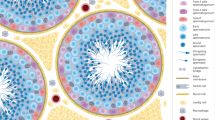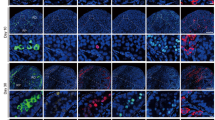Abstract
Spermatogenesis is one of the most complex and longest processes of sequential cell proliferation and differentiation in the body, taking more than a month from spermatogonial stem cells, through meiosis, to sperm formation1,2. The whole process, therefore, has never been reproduced in vitro in mammals3,4,5, nor in any other species with a very few exceptions in some particular types of fish6,7. Here we show that neonatal mouse testes which contain only gonocytes or primitive spermatogonia as germ cells can produce spermatids and sperm in vitro with serum-free culture media. Spermatogenesis was maintained over 2 months in tissue fragments positioned at the gas–liquid interphase. The obtained spermatids and sperm resulted in healthy and reproductively competent offspring through microinsemination. In addition, neonatal testis tissues were cryopreserved and, after thawing, showed complete spermatogenesis in vitro. Our organ culture method could be applicable through further refinements to a variety of mammalian species, which will serve as a platform for future clinical application as well as mechanistic understanding of spermatogenesis.
This is a preview of subscription content, access via your institution
Access options
Subscribe to this journal
Receive 51 print issues and online access
$199.00 per year
only $3.90 per issue
Buy this article
- Purchase on Springer Link
- Instant access to full article PDF
Prices may be subject to local taxes which are calculated during checkout




Similar content being viewed by others
References
Clermont, Y. Kinetics of spermatogenesis in mammals: seminiferous epithelial cycle and spermatogonial renewal. Physiol. Rev. 52, 198–236 (1972)
Russell, L. D., Ettlin, R. A., SinhaHikim, A. P. & Clegg, E. D. in Histological and Histopathological Evaluation of the Testis 1–40 (Cache River, 1990)
Staub, C. A century of research on mammalian male germ cell meiotic differentiation in vitro . J. Androl. 22, 911–926 (2001)
Parks, J. E., Lee, D. R., Huang, S. & Kaproth, M. T. Prospects for spermatogenesis in vitro . Theriogenology 59, 73–86 (2003)
La Salle, S., Sun, F. & Handel, M. A. Isolation and short-term culture of mouse spermatocytes for analysis of meiosis. Methods Mol. Biol. 558, 279–297 (2009)
Miura, T., Yamauchi, K., Takahashi, H. & Nagahama, Y. Hormonal induction of all stages of spermatogenesis in vitro in the male Japanese eel (Anguilla japonica). Proc. Natl Acad. Sci. USA 88, 5774–5778 (1991)
Sakai, N. Transmeiotic differentiation of zebrafish germ cells into functional sperm in culture. Development 129, 3359–3365 (2002)
Champy, C. Quelques résultats de la méthode de culture des tissues. Arch. Zool. Exp. Gen. 60, 461–500 (1920)
Martinovitch, P. N. Development in vitro of the mammalian gonad. Nature 139, 413 (1937)
Steinberger, A., Steinberger, E. & Perloff, W. H. Mammalian testes in organ culture. Exp. Cell Res. 36, 19–27 (1964)
Steinberger, A. & Steinberger, E. Factors affecting spermatogenesis in organ cultures of mammalian testes. J. Reprod. Fertil., Suppl. 2, 117–124 (1967)
Feng, L. X. et al. Generation and in vitro differentiation of a spermatogonial cell line. Science 297, 392–395 (2002)
Rassoulzadegan, M. et al. Transmeiotic differentiation of male germ cells in culture. Cell 75, 997–1006 (1993)
Staub, C. et al. The whole meiotic process can occur in vitro in untransformed rat spermatogenic cells. Exp. Cell Res. 260, 85–95 (2000)
Trowell, O. A. The culture of mature organs in a synthetic medium. Exp. Cell Res. 16, 118–147 (1959)
Tanaka, H. et al. Identification and characterization of a haploid germ cell-specific nuclear protein kinase (Haspin) in spermatid nuclei and its effects on somatic cells. J. Biol. Chem. 274, 17049–17057 (1999)
Nakanishi, T. et al. Real-time observation of acrosomal dispersal from mouse sperm using GFP as a marker protein. FEBS Lett. 449, 277–283 (1999)
Ventelä, S. et al. Regulation of acrosome formation in mice expressing green fluorescent protein as a marker. Tissue Cell 32, 501–507 (2000)
Gohbara, A. et al. In vitro murine spermatogenesis in an organ culture system. Biol. Reprod. 83, 261–267 (2010)
Goetz, P., Chandley, A. C. & Speed, R. M. Morphological and temporal sequence of meiotic prophase development at puberty in the male mouse. J. Cell Sci. 65, 249–263 (1984)
Goldsborough, M. D. et al. Serum-free culture of murine embryonic stem (ES) cells. Focus 20, 8–12 (1998)
Price, P. J., Goldsborough, M. D. & Tilkins, M. L. Embryonic stem cell serum replacement. PCT/US98/00467: WO 98/30679 (1998)
Wachs, F. P. et al. High efficacy of clonal growth and expansion of adult neural stem cells. Lab. Invest. 83, 949–962 (2003)
Tres, L. L. & Kierszenbaum, A. L. Viability of rat spermatogenic cells in vitro is facilitated by their coculture with Sertoli cells in serum-free hormone-supplemented medium. Proc. Natl Acad. Sci. USA 80, 3377–3381 (1983)
Sharpe, R. M. in Sertoli Cell Biology (eds Skinner, M. K. & Griswold, M. D. ) 199–216 (Elsevier Academic Press, 2006)
Ogonuki, N. et al. The effect on intracytoplasmic sperm injection outcome of genotype, male germ cell stage and freeze-thawing in mice. PLoS ONE 5, e11062 (2010)
Ogura, A., Inoue, K. & Matsuda, J. Mouse spermatid nuclei can support full term development after premature chromosome condensation within mature oocytes. Hum. Reprod. 14, 1294–1298 (1999)
Acknowledgements
We thank S. Yoshida and G. Yoshizaki for comments and pre-submission review. We thank A. Tanaka and Y. W. Zheng for their technical help in flow cytometric analysis. T.O. is grateful to his mentor R. L. Brinster for his advice on devising the experimental strategies and for his encouragements. We would like to thank A. Steinberger and the late E. Steinberger whose work in the study of in vitro spermatogenesis became the ground work for our present study. This work was supported by a Grant-in-Aid for Scientific Research on Innovative Areas, “Regulatory Mechanism of Gamete Stem Cells” (#20116005); a Grant-in-Aid for Scientific Research (C) (#21592080) from the Ministry of Education, Culture, Sports, Science, and Technology, Japan; a grant from the Yokohama Foundation for Advancement of Medical Science; and a grant for Research and Development Project II (No.S2116) of Yokohama City University, Japan (to T.O.).
Author information
Authors and Affiliations
Contributions
T.S. performed the experiments, interpreted the results, and prepared the manuscript. K.K. performed all culture experiments. A.G. contributed to the culture experiments. K.I. and N.O. performed microinsemination experiments. A.O. performed microinsemination experiments and discussed the results. Y.K. supervised the project and discussed the results. T.O. designed and performed the experiments and wrote the manuscript.
Corresponding author
Ethics declarations
Competing interests
The authors declare no competing financial interests.
Supplementary information
Supplementary Information
The file contains Supplementary Figures 1-11 with legends and Supplementary Tables 1-2. (PDF 1252 kb)
Rights and permissions
About this article
Cite this article
Sato, T., Katagiri, K., Gohbara, A. et al. In vitro production of functional sperm in cultured neonatal mouse testes. Nature 471, 504–507 (2011). https://doi.org/10.1038/nature09850
Received:
Accepted:
Published:
Issue Date:
DOI: https://doi.org/10.1038/nature09850
This article is cited by
-
Seeding the meiotic DNA break machinery and initiating recombination on chromosome axes
Nature Communications (2024)
-
Advances of three-dimensional (3D) culture systems for in vitro spermatogenesis
Stem Cell Research & Therapy (2023)
-
A pumpless monolayer microfluidic device based on mesenchymal stem cell-conditioned medium promotes neonatal mouse in vitro spermatogenesis
Stem Cell Research & Therapy (2023)
-
Generation of rat offspring using spermatids produced through in vitro spermatogenesis
Scientific Reports (2023)
-
Culture-space control is effective in promoting haploid cell formation and spermiogenesis in vitro in neonatal mice
Scientific Reports (2023)
Comments
By submitting a comment you agree to abide by our Terms and Community Guidelines. If you find something abusive or that does not comply with our terms or guidelines please flag it as inappropriate.



